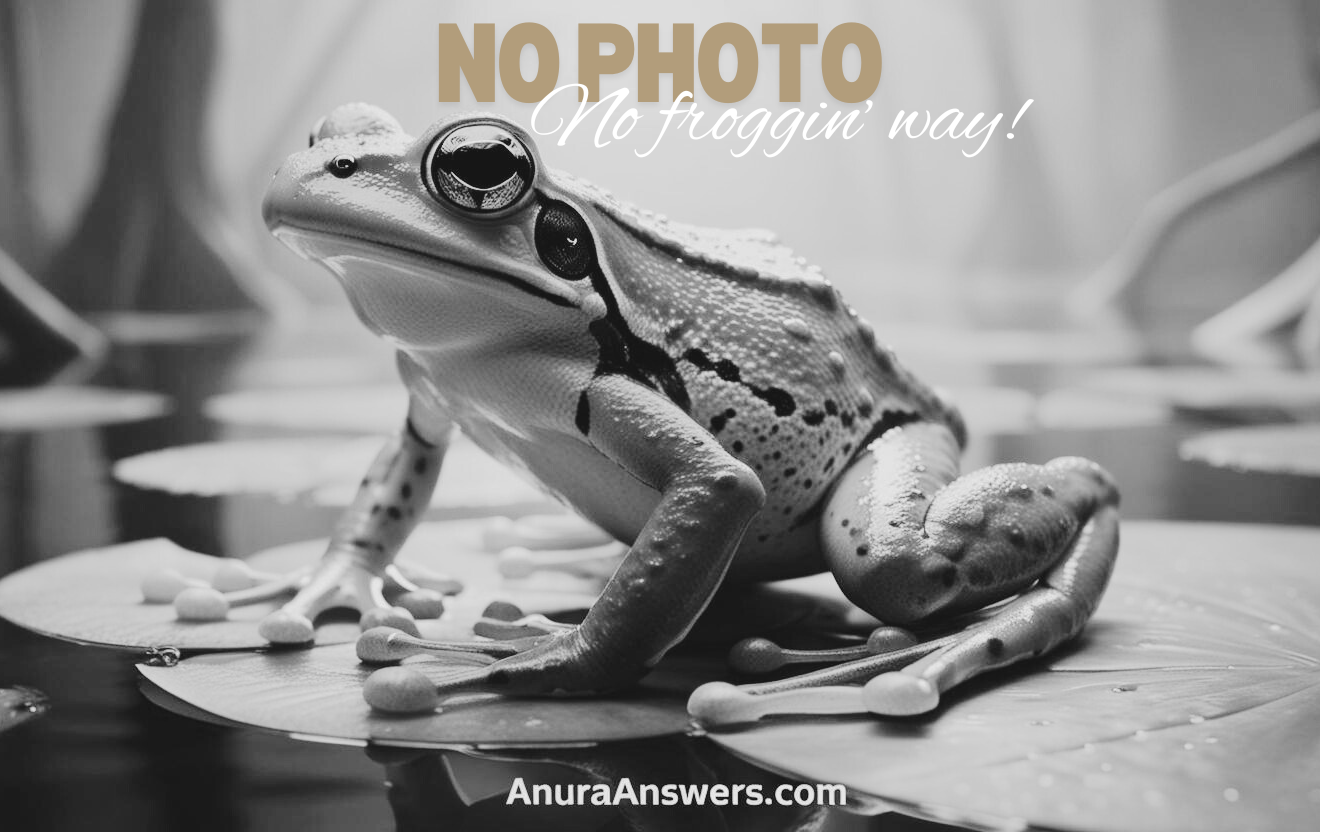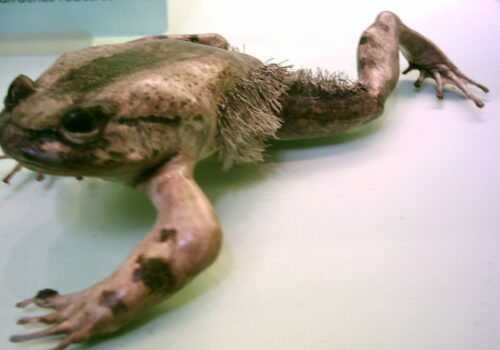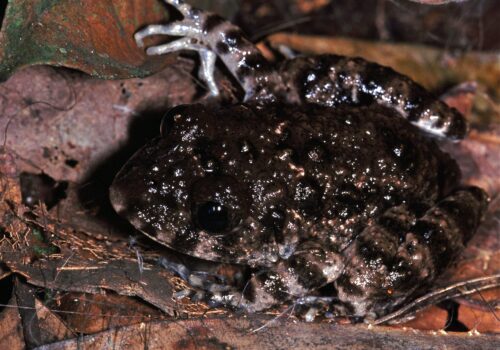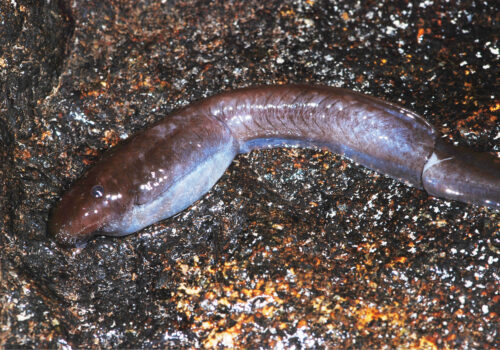- Hidden Wonders of the Forest: Exploring the Enigmatic Leptodactylodon bueanus Frog
Hidden Wonders of the Forest: Exploring the Enigmatic Leptodactylodon bueanus Frog#
Within the lush and mist-covered forests of central Africa, amidst damp leaves and moss-clad stones, lies a secretive and rarely seen amphibian, the Leptodactylodon bueanus. Often overshadowed by better-known rainforest dwellers, this diminutive yet remarkable frog species (scientifically classified as Leptodactylodon bueanus) possesses an intriguing life, quiet charm, and critically important ecological role. Despite its modest profile, discovering the life hidden beneath leaf litter and stream edges reveals an intricate narrative of survival, adaptation, and interdependence.
What truly sets the Leptodactylodon bueanus apart is its incredible ability to remain unnoticed. Not known for flashy displays or vivid colors, this amphibian thrives on subtlety and concealment. Offering valuable lessons about biodiversity and conservation, this frog invites us into a hidden world of dense foliage, running streams, and vibrant ecosystems teeming with life—if we have the patience and curiosity to seek it out.
Taxonomy and Classification#
Leptodactylodon bueanus belongs to the family Arthroleptidae, a diverse and widespread group of frogs often characterized by cryptic coloration and a reclusive, terrestrial lifestyle. First scientifically described in 1906 by renowned herpetologist George Albert Boulenger, these fascinating, ground-dwelling amphibians have intrigued biologists for over a century.
The genus Leptodactylodon, to which bueanus belongs, comprises specialized frogs often occupying isolated, pristine forest habitats. Closely related and similar in appearance to other Arthroleptids, this species nonetheless holds distinct genetic and ecological traits that clearly set it apart from relatives, positioning it as a fascinating subject for conservation research and evolutionary study.
Natural Habitat#
Nestled within the equatorial forests of Cameroon and Equatorial Guinea, the Leptodactylodon bueanus inhabits a region of breathtaking biodiversity. Here, the terrain rises gently into lush mountains cloaked in dense, humid rainforests punctuated by swiftly flowing streams and seasonal rivers. Known predominantly from mountainous regions including Mount Cameroon, its preferred elevation ranges from approximately 600 to 1,500 meters—a zone dense with fern-covered streams, mossy rocks, and shaded forest floors.
Life Beneath the Leaf Litter#
A preference for secluded, humid microhabitats defines much of the frog’s daily life. Beneath thick layers of fallen leaves, twisted roots, or under dense forest cover, the frog flourishes, protected from harsh sunlight, desiccation, and predators. During the rainy season, when streams swell, and the forest bursts into fresh life, Leptodactylodon bueanus becomes more active, moving about unseen beneath the forest vegetation, close to streams where moisture levels remain reliably high.
The streams themselves create ideal conditions for both adults and their tadpoles. Slow-moving, pristine freshwater habitats provide oxygen-rich water essential for developmental stages. This precise positioning highlights the species’ remarkable specialization and dependency on a delicate environmental balance.
Physical Characteristics#
At first glance, the Leptodactylodon bueanus hardly appears exceptional. Measuring approximately three to five centimeters from snout to vent, it presents a modest, unobtrusive appearance. However, closer examination reveals exquisite adaptations suited perfectly to its camouflaged lifestyle.
Master of Subtle Camouflage#
Its dorsal surface blends seamlessly with the dark browns, olives, and earthy shades of the forest floor. Fine patterns resembling leaf veins or shadows give it an almost perfect camouflage, rendering it nearly invisible when stationary against leaf litter. The frog’s skin texture further aids concealment: rough, warty patches intermingle with smoother regions, mimicking wet moss-covered stones.
Adaptations to a Moist Life#
Large, golden-brown eyes set prominently forward reflect its crepuscular and nocturnal habits, providing excellent night vision necessary for hunting insects. Long, muscular hind legs allow rapid, decisive leaps to escape predators or catch prey. Slightly swollen fingertips help it traverse moist cascades and slippery rocks, providing a secure grip in wet conditions typical of its rainforest realm.
Behavior and Life Cycle#
Observing the behavior of Leptodactylodon bueanus can challenge even skilled naturalists. Primarily nocturnal, these frogs shelter quietly during daylight hours, emerging only after sundown to feed, mate, and interact within their secretive communities.
A Quiet Hunter in the Dark#
Primarily insectivorous, these amphibians favor ants, termites, small beetles, and other tiny arthropods abundant in the rainforest floor. Hunting is an exercise in practiced stealth and patience, with the frog lying immobile until prey approaches, then suddenly seizing its target with a rapid flash of its sticky tongue. Such a precise hunting strategy conserves energy and maintains the frog’s secretive anonymity.
A Haunting Mating Chorus#
During rainy seasons, subdued yet distinctive mating calls emerge from sheltered niches along streams—a chorus easily overlooked in the darkness. Males position themselves strategically within damp crevices or near streambanks, emitting gentle rhythmic trills to attract females. Following successful courtship, female frogs deposit clusters of eggs hidden beneath submerged stones or leaf litter adjacent to slow-moving stream segments.
Tadpole life is equally secretive. Unlike many amphibians whose tadpoles freely swim through open waters, those of Leptodactylodon bueanus remain hidden, developing sheltered beneath stream debris or between gravel patches submerged in freshwater streams—another remarkable adaptation protecting vulnerable offspring from predators. After several weeks of quiet growth, tiny froglets emerge fully metamorphosed, ready to stake their claim on the shadowy forest floor.
Ecological Role#
While small and secretive, the ecological influence of Leptodactylodon bueanus extends significantly across its habitat. As both predator and prey, these frogs occupy essential roles within the forest food web.
A Balance Keeper of the Forest#
By consuming large quantities of terrestrial insects and arthropods, the frog aids in controlling insect populations, indirectly affecting plant health and reproduction. This insectivore role contributes toward ecosystem health, influencing everything from leaf decomposition rates to nutrient recycling.
Simultaneously, as prey, Leptodactylodon bueanus feeds larger rainforest creatures, including birds, snakes, and small mammals, ensuring overall ecosystem resilience and diversity. With acute sensitivity to environmental changes, amphibians like these frogs also serve as critical indicators of ecosystem health, alerting researchers to subtle yet significant environmental disturbances.
Threats and Conservation Status#
The remote forest valleys frequented by Leptodactylodon bueanus have provided some protective buffer. Nevertheless, these frogs are not immune to the threats afflicting amphibians globally. Deforestation, habitat fragmentation, agricultural encroachment, and climate change all pose serious and mounting pressures.
An Amphibian at Crossroads#
Currently classified as Critically Endangered by the International Union for Conservation of Nature (IUCN), the species faces immediate threats to survival. Intensive farming practices, logging, and expanding infrastructure near Mount Cameroon and elsewhere directly reduce suitable habitats and fragment populations, limiting breeding and genetic exchange.
Combined with overarching threats like climate change altering rainfall patterns and introducing diseases (such as chytridiomycosis), the need for coordinated conservation becomes ever more urgent. Conservation initiatives currently focus on habitat protection and restoration, national parks designation, and educating local communities about their unique biodiversity.
Cultural and Scientific Significance#
Beyond its biological and ecological relevance, Leptodactylodon bueanus holds intrinsic cultural value in local traditions, symbolizing rainforest health, subtlety, and harmony with nature. For scientists, this species also represents an invaluable living laboratory advancing knowledge of amphibian adaptations, evolutionary processes, and rainforest ecosystem integrity.
Conclusion: An Invitation to Conservation Action#
Unassuming yet profoundly significant, the Leptodactylodon bueanus epitomizes the intricacies and beauty hidden away in Earth’s last refuges of wild abundance. Its story, filled with quiet resilience, complex behaviors, and profound ecological interconnectedness, challenges us to open our eyes to overlooked wonders and join the fight to preserve Earth’s rapidly diminishing natural heritage.
By learning more and advocating for conservation policies that protect forest habitats, each of us can ensure the continued existence and flourishing of hidden gems like this shy rainforest dweller.










